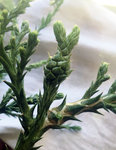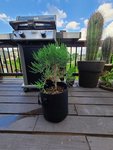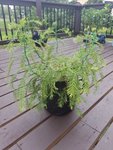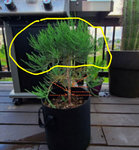I don't know nothin' about these trees, but generally speaking, trees favor new growth and shed foliage and branches that are less productive. You need to treat them the way you would if you were maintaining taper. The top of the tree can't be allowed unfettered growth and lower foliage ignored. If you want the standard Pine/Christmas tree shape/taper, you need to keep the foliage/branches trimmed at approximately the same pyramidal shape and density from the tip-top down to some point where the trunk will not be tapered anymore because there are no branches below that point, like in a forest.
There are many competing factors at play. The cone shape is a pretty optimal shape...surface area wise...for light collection. At some point, the shape cannot be maintained. Lateral branches get too heavy, nutrient transport stalls out, etc. From that point down, the tree will generally look more barrel like until issues like shading of branches, accumulated damage, etc...cause the branch to be aborted entirely.
But, I maintain that at 6' the factors that cause branch attrition are minimal and are mostly things we can control for. Here are some samples of young, but tall trees with branches all the way to the ground.

www.giant-sequoia.com
Click through the various locals for lots of examples. In some cases the lower branches have obviously been limbed for landscaping purposes. The second example on this page

www.giant-sequoia.com
claims to be 3 years old and is clearly a much denser tree than Emenon's. The advantages of growing in the ground

There is an incongruity built into that process that precludes max growth because you are limiting growth in the area that the tree would prefer to have its strongest growth so that the lower branches can be short enough to still be useful in the final design rather than foliage way outboard of where you need it. I don't think you can have both high growth and lower branches with foliage in close, but I've been wrong before...
I challenge how significant apical growth strength is in a 6' tree. I do not question that sequoia would prefer to grow up than out. I do question whether at the scale of our hobbiest trees how dominating that effect really is. I think we tip the scales a lot towards apical dominance by planting in pots. That limits the tree's resource significantly. Resources will go to the top before lateral so if the resources are significantly scarce, we only see top growth. However, to form a cone the actual volume of foliage being added to lower branches _must_ exceed the volume being added to the top branches. That's just math. The lower branches provide more surface area than the upper ones. The sites above show plenty of trees with cone like shapes out to tens of feet wide. To make that shape, the lateral branches must put out some significant growth as well.
Now for bonsai, those lateral branches start to lose their usefulness when they get too lateral for the final form. If back budding isn't an issue, then there's not much of a problem. If the tree doesn't back bud easily, we may have issues. I honestly don't have enough experience with sequoia to know how the closer in portions of branches will react when trimmed back. I've read resources (wish I remembered where!) that said sequoia will bud anywhere cambium is exposed. Old growth dowsn't tend to backbud simply because the bark is too thick. The artical (scientific journal if I remember correctly) suggested that if the bark were shipped away down to the cambium and the area provided sufficient light, buds would grow.
Again, on our tiny trees, I'm not sure the bark will ever get thick enough to hinder buds. But that's something that's easy to experiment with. Nick the bark on the lower trunk. Let that part of the trunk receive light. See if a bud sprouts

I might even try that one one of my own trees just for kicks!
Dawn Redwood beats that game because you can chop all the branches back to the trunk and start over to create branches in proportion to each other after you've grown the trunk to the size you want. That might work on Bald Cypress, too, but I'm speculating.
In my opinion, the problem with this "trick" on dawns is that you don't get the characteristic armpits

www.kollarnursery.com
That's another character quirk between dawn redwoods and bald cypress. Most people focus on the opposite vs alternating leaf habit because that's evident on trees of any age. On older trees, dawns grow armpits. This site has a comparison picture of branches of dawn vs bald near the bottom

landscapeplants.oregonstate.edu
The armpits form as new growth flows around existing branches. If you limb the tree after the trunk has reached an optimal size, the new branches form on the surface and, since the trunk is mostly developed to the thickness you want, there's no growth to build armpits.
How realistic it is to grow armpits on a bonsai scale tree, I don't know. Unfortunately, I did not get the opportunity to lift specimen I had in the ground when we moved 10 years ago

That tree was several inches in diameter and 15' tall and was meant to go into a bonsai pot but circumstances didn't allow me to get it out of the ground when we sold the house...sigh...




